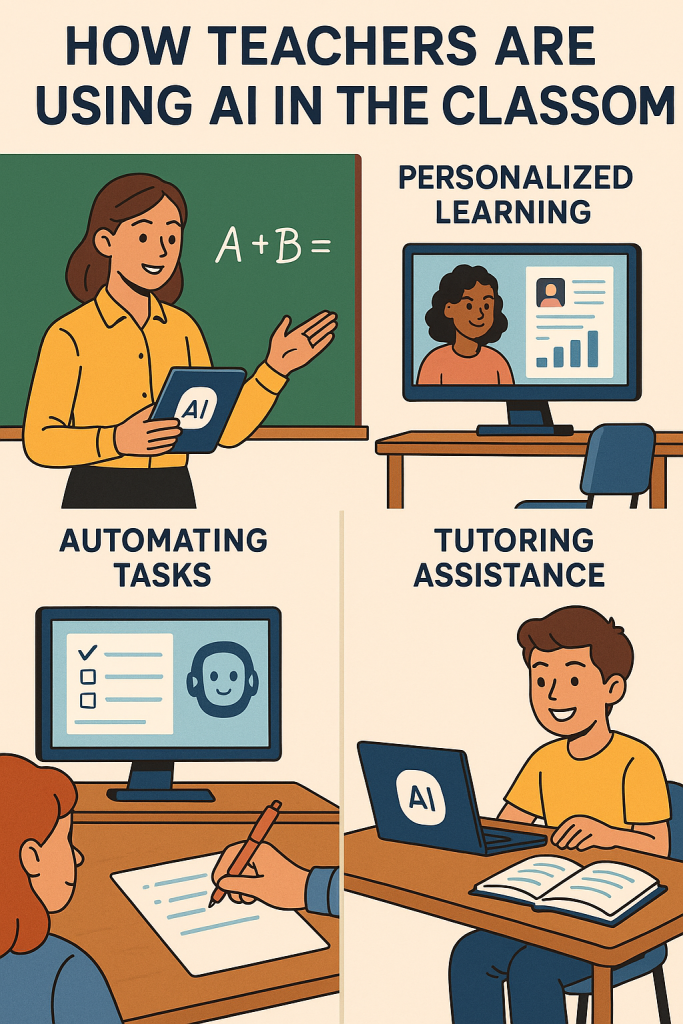Artificial intelligence, or AI, is no longer just a futuristic idea. It has quietly made its way into classrooms around the world. Teachers are discovering new ways to use AI tools for tutoring, grading, and lesson planning. These tools can save time, make learning more personal, and even help struggling students keep up.
But with these opportunities come concerns. How can teachers make sure students don’t misuse AI for cheating? And how can schools keep education fair and personal when technology is doing more of the work? This article will walk you through the benefits, the risks, and real examples of how AI is being used in classrooms today.
Table of Contents
Key Takeaways
- AI can support teachers with grading assignments, saving hours of work.
- Tools like chatbots and apps provide tutoring help outside the classroom.
- AI helps teachers plan lessons tailored to student needs.
- Risks include plagiarism, over-reliance, and privacy concerns.
- Teachers still play the most important role: guiding, encouraging, and teaching critical thinking.
How Teachers Use AI in the Classroom
1. AI for Tutoring
Think of AI tutoring as a digital assistant for students. Tools like chatbots or learning apps can answer homework questions, explain concepts in simple terms, and even quiz students.
- For example, a student struggling with algebra can ask an AI app to explain step by step how to solve an equation.
- Language learners use AI-powered tools to practice conversations and get instant corrections.
- Some schools provide access to AI tutors so students can review lessons after class at their own pace.
This doesn’t replace teachers. Instead, it gives students extra support when a teacher isn’t available, like at home in the evening.
2. AI for Grading
Grading can take up hours of a teacher’s week. AI programs can help by quickly checking:
- Multiple-choice tests
- Short written answers
- Even longer essays, by flagging grammar, spelling, and clarity issues
This means teachers spend less time on routine checking and more time giving personal feedback. For example, AI might highlight that many students struggled with the same question. The teacher can then review that topic in class.
Of course, teachers don’t simply accept whatever the AI suggests. They double-check results to make sure the grading is fair and accurate.

3. AI for Lesson Planning
Planning lessons for a classroom of students with different needs is tough. AI tools can help teachers design lesson plans by:
- Suggesting activities based on the subject and grade level
- Creating quizzes or practice questions in minutes
- Recommending resources like videos or articles that match the curriculum
For example, a history teacher might ask an AI tool to create a set of discussion questions about World War II. The tool can provide options, which the teacher then adjusts to fit the class.
This doesn’t mean teachers are being replaced. Instead, it reduces repetitive work so they can spend more time actually teaching.
The Risks of Using AI in Education
While AI has many benefits, it also brings challenges. Teachers are careful about how and when to use it. Some of the main risks include:
- Plagiarism and Cheating
Students may use AI tools to write essays or complete assignments without doing the work themselves. Teachers now use plagiarism checkers that can spot AI-generated writing. - Over-Reliance on Technology
If students always turn to AI for answers, they may not develop problem-solving or critical thinking skills. Teachers encourage balance: use AI for practice, but still learn the process. - Privacy Concerns
Many AI apps collect data on students’ performance. Schools need to make sure this information stays private and secure. - Bias in AI Tools
Sometimes AI programs give incorrect or biased answers. Teachers review and guide students to think critically about the information they receive.
Real-Life Examples
- In some U.S. classrooms, teachers use AI programs to track student progress. If a student struggles with fractions, the program alerts the teacher so they can provide extra help.
- Language classes often use AI-powered tools for speech practice. Students can speak into the app, and it gives feedback on pronunciation.
- Teachers in busy schools report saving several hours each week by using AI to generate practice quizzes and review questions.
Beginner’s Classroom AI Toolkit
Here is a simple step-by-step starting guide for teachers who want to explore AI safely and effectively:
- Start Small
Pick one task where you need extra help, like quiz creation or grading short answers. Try a single AI tool for that task before adding more. - Safe Tutoring Apps
- Khan Academy’s Khanmigo (AI tutor for different subjects)
- Duolingo (AI-based language practice)
- Grading Helpers
- Gradescope (helps grade multiple-choice and written responses)
- Turnitin Draft Coach (checks writing and flags possible plagiarism)
- Lesson Planning Tools
- ChatGPT or similar AI assistants (generate ideas, quizzes, and lesson outlines)
- Curipod (creates interactive presentations and class activities)
- Keep Human Oversight
Always review AI suggestions before using them with students. Think of AI as a teaching assistant, not a replacement. - Discuss AI with Students
Explain how these tools work and set clear rules. Encourage them to use AI as a helper, not as a shortcut for doing assignments. - Stay Updated
AI in education is growing fast. Check with your school or district for approved tools and best practices.
Final Thoughts
AI is not here to replace teachers. It is a tool, much like calculators or computers once were. Used wisely, AI can make classrooms more efficient, give students extra support, and free up teachers to focus on what matters most: guiding young minds.
The key is balance. By understanding both the benefits and risks, schools can use AI in a way that improves learning while still keeping education personal and fair.
